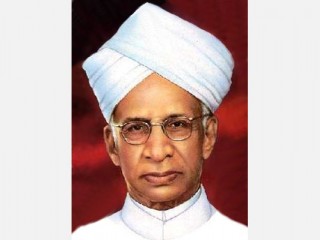


Sarvepalli Radhakrishnan was born into a middle class family at Tirutani in Tamil Nadu, a town in Madras Presidency, British India, 64 km to northwest of Madras (now Chennai). His early years were spent in Tirutani and Tirupati. His father was a subordinate revenue official in the service of a local Zamindar (landlord). His primary education was at Primary Board High School at Tirutani. In 1896, he was shifted to Hermansburg Evangelical Lutheral Mission School at Tirupati.
Radhakrishnan went through most of his education on scholarships. He joined the Voorhee's College in Vellore but switched to the Madras Christian College at the age of 17. He graduated with a Master's degree in Philosophy from the Madras Christian College in 1906, being one of its most distinguished alumni. Radhakrishnan wrote his thesis for the M.A. degree on "The Ethics of the Vedanta and its Metaphysical Presuppositions". He was afraid that his M.A. thesis, "The Ethics of the Vedanta" would offend his philosophy professor, Dr. A.G. Hogg. Instead, Dr. Hogg commended Radhakrishnan on doing an excellent job. Radhakrishnan's M.A. thesis was published when he was only 20. Philosophy was not his personal choice, but seemingly an accident. A cousin of his who had graduated from the same college handed over to him the textbooks in philosophy. As Radhakrishnan was poor at this juncture of his life, this incident decided his future career. Later on he felt deep interest in his subject and wrote many acclaimed works on philosophy, both eastern and western.
Radhakrishnan was married to Sivakamu, a distant cousin, in 1904 at the age of 16. His bride was then only 10 years old. The marriage was a traditional Indian arranged marriage. They had five daughters and a son, Sarvepalli Gopal.
In 1914, in a strange twist of fate, Radhakrishnan met Srinivasa Ramanujan, the mathematical genius. Srinivasa was leaving for Cambridge for studies and had come to seek Radhakrishnan's blessings because a goddess came in his dream and told him to do so before undertaking the trip. The two never met again.
In 1918, Radhakrishnan was selected as Professor of Philosophy by the University of Mysore. By that time, he had written many articles for journals of repute like The Quest, Journal of Philosophy and the International Journal of Ethics. He completed his first book "The Philosophy of Rabindranath Tagore". He believed Tagore's philosophy to be the "genuine manifestation of the Indian spirit." Radhakrishnan's second book, "The Reign of Religion in Contemporary Philosophy" was published in 1920.
In 1921, he was appointed as a professor in philosophy to occupy the King George V Chair of Mental and Moral Science at the University of Calcutta. Radhakrishnan represented the University of Calcutta at the Congress of the Universities of the British Empire in June 1926 and the International Congress of Philosophy at Harvard University in September 1926. In 1929, Radhakrishnan was invited to take the post vacated by Principal J. Estlin Carpenter in Manchester College, Oxford. This gave him the opportunity to lecture to the students of the University of Oxford on Comparative Religion. For his services to education, he was knighted by the British Government in 1931, but did not use the title in personal life preferring instead his academic title 'Doctor'. He was the Vice-Chancellor of Andhra University from 1931 to 1936. In 1936, Radhakrishnan was named Spalding Professor of Eastern Religions and Ethics at the University of Oxford, and was elected a Fellow of All Souls College. In 1939, Pt. Madan Mohan Malaviya invited him to become Vice-Chancellor of Banaras Hindu University. He continued as its Vice-Chancellor till January, 1948. When India became independent in 1947, Radhakrishnan represented India at UNESCO, and was later Ambassador of India to the Soviet Union, from 1949 to 1952. He was also elected to the Constituent Assembly of India.
Radhakrishnan was elected as the first Vice President of India in 1952. In 1956, his wife Sivakamamma died. They were married for over 51 years. He was elected as the second President of India (1962-1967). When he became President, some of his students and friends requested him to allow them to celebrate his birthday, 5 September.
He replied, "Instead of celebrating my birthday, it would be my proud privilege if 5 September is observed as Teachers' Day".
His birthday has since been celebrated as Teachers' Day in India. Radhakrishnan along with Ghanshyam Das Birla and a few other Social Workers in pre independence era formed Krishnarpan Charity Trust.


No comments:
Post a Comment